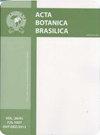Floristic inventory and conservation of one of the most striking coastal mountains in the Brazilian Atlantic Forest
IF 1.1
4区 生物学
Q4 PLANT SCIENCES
引用次数: 1
Abstract
The Atlantic Forest is made up of different vegetation types over extensive latitude. Most of its remnants are in mountain ranges, which are responsible for the maintenance of most endemic and threatened species in this domain. Here we present the floristic composition of the Área de Proteção Ambiental Mestre Álvaro (APAMA), a coastal massif at Espírito Santo State with expressive altitudinal amplitude (100-800 a.s.l.) containing remnants never floristically studied. Knowing the composition of this protected area is important because it includes an altitudinal range not yet evaluated in floristic comparisons involving highland and lowland forests between the latitudes 18-21° S. We found 493 species (in 292 genera and 91 families): ten are regional endemic species, nine are new records of occurrence for the state, and 52 are under some degree of threat of extinction. Our results indicate the presence of flora elements’ typical of both highland and lowland forests, which makes the APAMA essential in a scenario extremely fragmented. Finally, our data provide an unprecedented floristic list for regional forest restoration projects, as well as an invaluable source of data for biogeographic studies that seek to understand the effect caused by neighboring vegetation types on the composition of lowland forests.巴西大西洋森林中最引人注目的沿海山脉之一的植物区系清单和保护
大西洋森林在广泛的纬度上由不同的植被类型组成。它的大部分遗迹都在山脉中,这些山脉负责维护该领域大多数特有和受威胁的物种。本文介绍了Área de prote o Ambiental Mestre Álvaro (APAMA)的植物区系组成,这是一个位于Espírito Santo State的沿海块体,具有明显的高度振幅(100-800 a.s.l.),其中包含从未进行过植物区系研究的残留物。了解该保护区的组成是很重要的,因为它包括了一个尚未在纬度18-21°s之间的高原和低地森林植物区系比较中评估的海拔范围。我们发现了493种(隶属于91科292属):10种是区域特有物种,9种是该州的新记录,52种处于一定程度的灭绝威胁。我们的研究结果表明,高原和低地森林中都存在典型的植物区系元素,这使得APAMA在极度破碎的情景中必不可少。最后,我们的数据为区域森林恢复项目提供了前所未有的植物区系列表,也为寻求了解邻近植被类型对低地森林组成的影响的生物地理学研究提供了宝贵的数据来源。
本文章由计算机程序翻译,如有差异,请以英文原文为准。
求助全文
约1分钟内获得全文
求助全文
来源期刊

Acta Botanica Brasilica
PLANT SCIENCES-
CiteScore
2.30
自引率
9.10%
发文量
32
审稿时长
6-12 weeks
期刊介绍:
Experimental, theoretical and applied papers on all aspects of plant (including algae) and fungi biology are welcome. The submitted manuscript or its essential content must not have been published previously or be under consideration for publication elsewhere. Contributions should be substantial, written in high-quality English and show general interest. We expect that the submitted manuscript presents a great novelty in Botany, and this should attract a wide audience. Considering this, case studies are only considered if the narrative and implications are provided to be of general interest. Thus, manuscripts that report aspects of local interest are discouraged unless the implications of the findings are wide-reaching. Manuscripts with agronomic subjects are expected to contain a substantial amount of basic plant biology. Please see below some details for specific area.
 求助内容:
求助内容: 应助结果提醒方式:
应助结果提醒方式:


